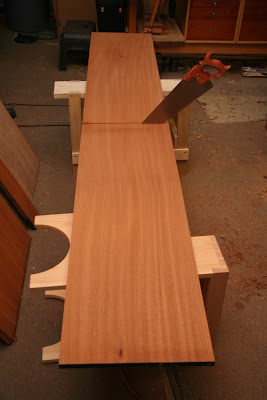The box has been put together and now it is time to put the front and back panels on. I had to created a rabbet all the way around the front and back of the carcass. This wasn't at all enjoyable. I'm not a big fan of routers (especially when not mounted in a table). The end result wasn't pretty. Fortunately this will all be covered up with faux rails and stiles. Balancing the router on such a narrow piece was a challenge. I made a fence to help. You can see the hamster bed being created at the bottom of the carcass. I had already cut and installed the back before taking this picture. Thus, the clippings were being captured inside the box. My 2-year old daughter (at the time) saw all the dust and asked me if I was making a sandbox. In this shot I'm cutting the front rabbets. After that the panels just drop in place and get screwed in.
After closing up the box it's time to cut the front off. This was a challenge to say the least. Keeping things up against the fence proved difficult. I put some feather boards on the saw but the box was too much for them. My 12-year old son was on the outfeed side of the table saw ready to catch it. I started by slicing the top and bottom all the way through. Once those cuts are made I stuck some boards ove the cuts I just made using double-sided tape. (note to self - don't buy anymore tape from Big Lots). This holds the box together so when you cut the sides things don't fall apart. The third side cut easily. The fourth - well - buy better tape next time (or use a glue gun).
After the front face has been cut off the edges need to be cleaned up. I then cut the front face in two to form the two doors. Unfortunately I didn't get a picture of that but you get the idea.
The doors have been put aside while work gets done on the inside. There will be three columns for drawers at the bottom (the original plan has two). I added a narrow/tall middle drawer to hold my glue bottles and oil cans. In this shot I'm cutting stopped dados to receive the vertical dividers for the drawers. The shelf above the drawers will receive the same stop dados on the underside. You start by marking your location and scribing lines with a knife. Then it's simply a matter of sawing down to the required depth. I just clamped an 8/4 piece of maple scrap (cutting board leftover) on the line and using my x-cut saw (Bad Axe Gloat!) sawed away. (Update: I've since realized that cutting stopped dados by hand isn't all that intuative. I will vlog my approach at a future date.
After the outsides of the dados have been formed it's time to clean out the waste. There is no better way to do that than with a router plane. That's got to be one of my favorite tools. I chiseled out the waste at the stop portion of the dado down to depth to prevent blowing out the edge with the router plane. This shot is taken from the back.
You've gotta love it when you can get cross grain curls like this with a router plane.
The dados are cut a tad bit narrow so you can sneak up on them with the side rabbet plane.
Next up - I spent the day dimensioning the lumber for the shelves and drawers. There will be a total of 7 drawers (mahogany sides and birdseye maple fronts. I'll be using half-blinds on the drawers (sort of). Things are going slowly right now because I'm finishing the inside of the cabinet in the process. I am no finisher that's for sure.





















